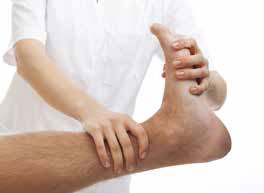
If the soles of your shoes show unusual wear patterns, one of the culprits might be the common condition of flat feet. Flat feet are normal in babies whose arches have not yet developed. The arch develops in childhood, and by the time you reach adulthood, a normal arch should be present.
But what about that unusual wear pattern on your shoe soles? If your feet have always been a bit flat, it should not be much of a concern. As long as you do not experience pain or discomfort, you might not even realize you’re flat-footed. But if you start noticing a progressive flattening of a foot that previously had a rounded, normal arch, then this may be a problem that requires attention.
First, let’s explain what having a “flat foot” really means. The arches of your feet are supported by tendons, and when the tendons work together as they should, they give the bottom of your foot a raised, rounded appearance. When they stop working, the arch flattens out (“fallen arches”). This can occur from a painful, progressive condition called posterior tibial tendon dysfunction (PTTD), where the tendon in the arch of your foot becomes inflamed, stretched or torn. Progressive flat feet may also be caused by injuries, nerve problems or conditions such as rheumatoid arthritis.
If you are diagnosed with PTTD, it is in your best interest to get treatment right away. Because this is a progressive condition, the longer you wait, the worse it gets—and early treatment can help reduce the need for surgery. Nonsurgical treatments involve rest and ice to relieve swelling and nonsteroidal anti-inflammatory medications (if your physician agrees) to reduce pain and inflammation. In addition, special orthotic supports, shoe modifications, braces and casts can give your arch the support it needs, while also allowing it the proper time to heal.
Physical therapy, including ultrasound to rehabilitate the tendon and stretching exercises, can help improve mobility and reduce pain. Should you require surgery, we can provide you with a regimen of exercises to perform once the tendon has healed. These include heel raises, isometric resistance exercises performed with a towel or rubber band, and stretching exercises.
If you suspect that your feet are getting flatter or that your arches have “fallen,” we can provide an exercise program to address your feet by relieving your symptoms and restoring your arch.
